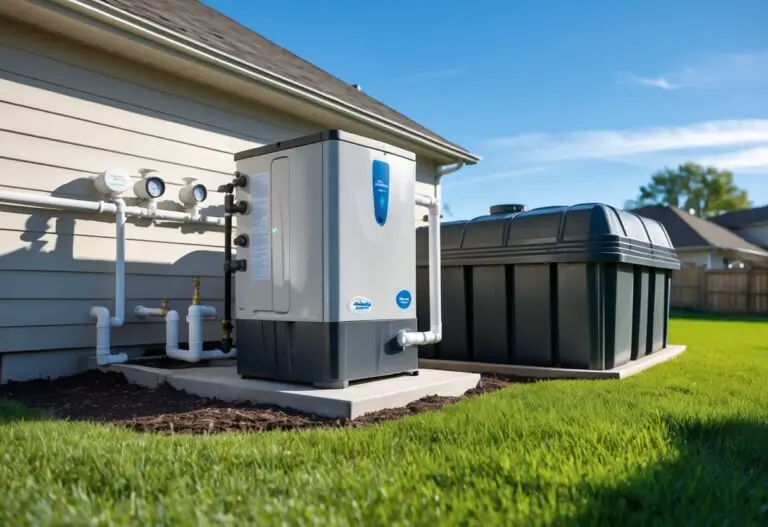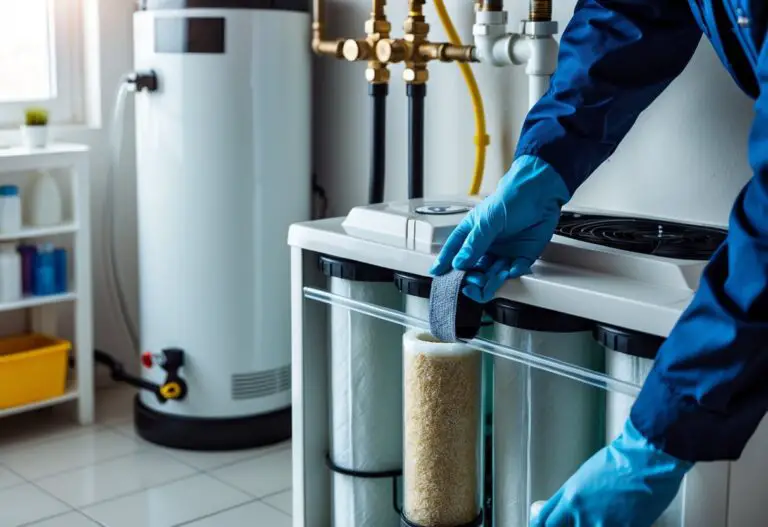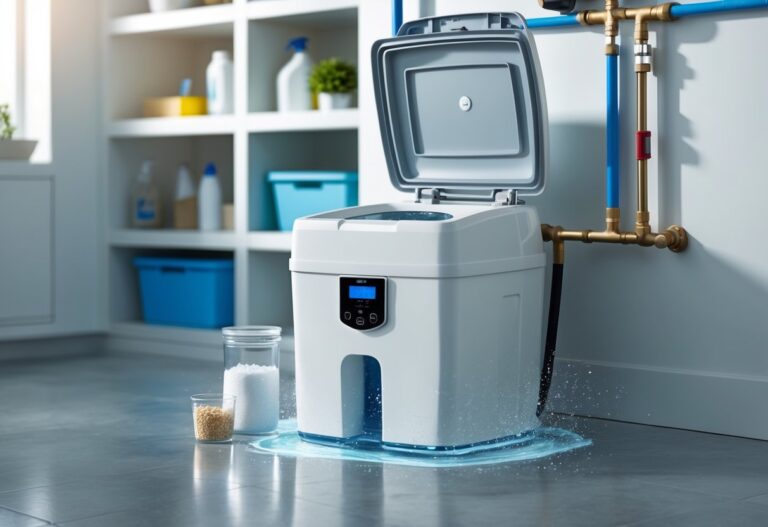If you’re thinking about getting a water softener, you probably wonder whether it needs to connect to a drain. Most water softeners need a drain because they must flush out collected minerals during their cleaning cycle. This process keeps your system working properly and your water soft.

Water softeners work by swapping hard minerals for sodium through a process called ion exchange. Over time, these minerals build up inside the system and need to be washed away. Without a drain, your water softener would overflow or stop working completely.
The drain setup affects where you can install your water softener and how much the installation costs. Understanding your drain options helps you plan better and avoid costly mistakes during setup.
Key Takeaways
- Water softeners need drains to remove collected minerals during their regular cleaning cycles
- Different drain types include floor drains, utility sinks, and properly trapped outlets with specific requirements
- Local plumbing codes determine where you can legally discharge water softener waste in your area
Why Water Softeners Require a Drain
Water softeners need drains to remove hardness minerals and salt during the regeneration process. Without proper drainage, these systems cannot function effectively and may cause water damage or contamination.
Regeneration and the Role of Drains
During regeneration, your water softener cleans itself to maintain peak performance. The system flushes out calcium and magnesium minerals that have built up in the resin bed.
This process happens automatically every few days or weekly, depending on your water usage and hardness levels. The regeneration cycle uses salt water from the brine tank to wash through the resin.
Your drain line carries this mineral-rich water away from the system. Without this connection, the dirty water would have nowhere to go. The drain prevents contaminated water from backing up into your home’s clean water supply.
Most systems use a ½-inch drain line made of durable materials like PVC or polypropylene. This size handles the water flow during regeneration cycles without clogging.
The drain connection must include an air gap to prevent backflow. This safety feature ensures dirty water cannot travel backward into your water softener or home plumbing.
Discharge of Minerals and Brine
Your water softener collects hardness minerals like calcium and magnesium during normal operation. These minerals must be removed regularly to keep the system working properly.
The brine solution created in your brine tank washes these minerals from the resin bed. This salty mixture picks up all the trapped hardness minerals as it flows through the system.
Common discharged materials include:
- Calcium carbonate
- Magnesium sulfate
- Salt water (brine)
- Iron particles
- Sediment and debris
The drain carries this waste water to your sewage system, septic tank, or approved outdoor location. Each regeneration cycle can discharge 25-50 gallons of mineral-rich water.
This discharge water contains high levels of sodium and hardness minerals. It cannot be reused and must be safely removed from your property.
Potential Issues Without Proper Drainage
A blocked or missing drain line can cause serious problems for your water softener system. Mineral buildup will damage the resin bed and reduce softening effectiveness.
Water damage becomes a major risk when drainage fails. Your system may overflow during regeneration, flooding your basement or utility room.
Poor drainage can contaminate your home’s water supply. Hard water minerals and salt can back up into clean water lines without proper flow direction.
Your resin bed may need expensive replacement if minerals cannot drain properly. Severely clogged systems can even burst during regeneration cycles.
System failure occurs when regeneration cannot complete successfully. Your water will remain hard, and scale buildup will return to your pipes and appliances.
Regular drain maintenance prevents these costly problems and keeps your water softener running smoothly for years.
Understanding the Water Softening Process
Water softeners remove hard minerals from your water through a chemical process called ion exchange. The resin tank holds special beads that swap calcium and magnesium for sodium ions.
Ion Exchange and Mineral Removal
Ion exchange is the core process that transforms hard water into soft water. Your water softener contains tiny resin beads that are charged with sodium ions.
When hard water flows through the resin tank, these beads attract calcium and magnesium minerals. The beads release sodium ions in exchange for the hard minerals.
Key minerals removed:
- Calcium
- magnesium
- Iron (in some cases)
This swap happens because calcium and magnesium have a stronger attraction to the resin beads than sodium does. The hard minerals stick to the beads while sodium enters your water supply.
The process continues until the resin beads become full of calcium and magnesium. At this point, your water softener needs to regenerate to keep working properly.
Function of the Resin Tank
The resin tank holds thousands of small plastic beads that do the actual water softening work. These beads are about the size of sand grains and are made from special materials.
Each bead can hold multiple mineral ions on its surface. Fresh resin beads start loaded with sodium ions from your salt supply.
Resin tank components:
- Plastic resin beads
- Distribution system
- Tank housing
- Inlet and outlet connections
Over time, the beads collect more calcium and magnesium than they can hold. This reduces your water softener’s ability to remove hard minerals effectively.
Your system monitors how much water has passed through and triggers regeneration when needed. This usually happens every 3 to 7 days depending on your water usage.
Creation of Soft Water
Soft water forms when sodium replaces the calcium and magnesium in your water supply. This trade creates water that feels different and behaves better for cleaning.
The sodium level in soft water is typically very low. Most people cannot taste the difference in drinking water after softening.
Benefits of soft water:
- Less soap scum buildup
- Cleaner dishes and glassware
- Softer feeling on skin and hair
- Better lather from soaps
Your softened water flows from the resin tank to your home’s plumbing system. All water-using appliances and fixtures receive this treated water.
The process happens continuously as long as the resin beads have sodium available for exchange. When regeneration occurs, your system briefly uses hard water while flushing the collected minerals down the drain.
Types of Drains and Alternative Setups
Water softeners typically need a drain connection to handle backwash water during regeneration cycles. Several drain options work for different home setups, while some newer systems offer drainless alternatives for specific situations.
Common Drain Options for Water Softeners
Floor drains are the simplest choice for basement installations. Most water softeners create enough pressure to push backwash water up through floor drains connected to your home’s sewer system.
Laundry tubs provide another easy indoor option. You can run the drain line directly into a utility sink or laundry tub. This setup works well when your water softener sits near your laundry area.
Sump pumps help when your resin tank sits below the main drain level. The pump collects backwash water in a basin and pushes it up to the proper drainage height.
For outdoor setups, dry wells offer a good solution. These are deep holes that let backwash slowly seep into the ground away from your home’s foundation.
French drains spread backwash over a wider area using a perforated pipe in a gravel-filled trench. This prevents sodium buildup in one spot.
Drainless Water Softener Alternatives
Some water treatment systems work without traditional drains. Template Assisted Crystallization (TAC) systems change mineral structure instead of removing them, so no regeneration or drain line is needed.
Electronic water conditioners use electromagnetic fields to alter mineral behavior. These systems mount directly on your water pipe and need only electrical power.
Reverse osmosis systems can soften small amounts of water at point-of-use locations. These systems do create wastewater but often drain to existing sink connections.
These alternatives work best for mild water hardness or specific applications where traditional drain connections aren’t possible.
Drain Line Installation Best Practices
Use ½-inch polypropylene tubing for most drain line installations. This size handles typical backwash flow rates without restriction.
Install an air gap between your drain line and the actual drain. This prevents dirty water from flowing back into your resin tank during drainage problems.
Keep drain lines as short and straight as possible. Long runs with multiple bends can restrict water flow and cause regeneration problems.
Check local codes before installation. Some areas restrict backwash discharge to protect groundwater supplies or septic systems.
Environmental and Plumbing Considerations
Water softener drainage affects both your home’s plumbing system and the environment around your property. The brine discharge contains high levels of salt and minerals that require careful handling to prevent damage to septic systems and comply with local environmental rules.
Impact on Septic Systems
Your septic system can face serious problems when connected to a water softener drain. The high salt content in brine discharge kills the helpful bacteria that break down waste in your septic tank.
Key septic system risks include:
- Bacterial die-off from excess sodium
- Slower waste breakdown
- System backups and failures
- Expensive repairs or replacements
The salt water also increases the liquid volume flowing into your septic system. This extra water can overwhelm the system during regeneration cycles.
Most septic systems cannot handle the 50-100 gallons of brine water that your water softener produces during each cleaning cycle. You should install a separate drain line that bypasses your septic system entirely.
Local Regulations and Environmental Effects
Many areas have strict rules about where you can drain water softener waste. Your local government may ban certain drainage methods to protect groundwater and soil.
Common drainage restrictions:
- No discharge into storm drains
- Prohibited drainage onto neighboring properties
- Required permits for certain installations
- Minimum distances from wells or water sources
The minerals and salt from your water softener can harm local plants and contaminate soil. High sodium levels change soil chemistry and make it harder for plants to absorb water.
You must check your local building codes before installing any drainage system. Some areas require professional installation or special permits for water softener drains.
Protecting Plumbing and Appliances
Proper drainage protects your plumbing system from backups and damage caused by brine discharge. Without adequate drainage, the salt water can corrode pipes and create blockages.
Drainage protection benefits:
- Prevents pipe corrosion from salt buildup
- Stops backflow into your soft water supply
- Reduces maintenance costs
- Extends equipment lifespan
Your drain line should use materials that resist salt corrosion. Plastic pipes work better than metal ones for water softener drainage connections.
Install an air gap between your water softener drain line and the actual drain. This prevents contaminated water from flowing back into your system during clogs or backups.
Regular maintenance of your drainage system keeps everything working properly and prevents costly repairs to your plumbing.





